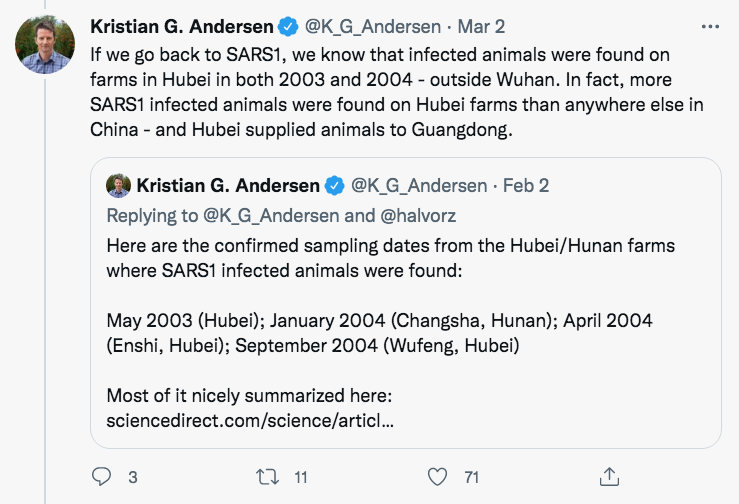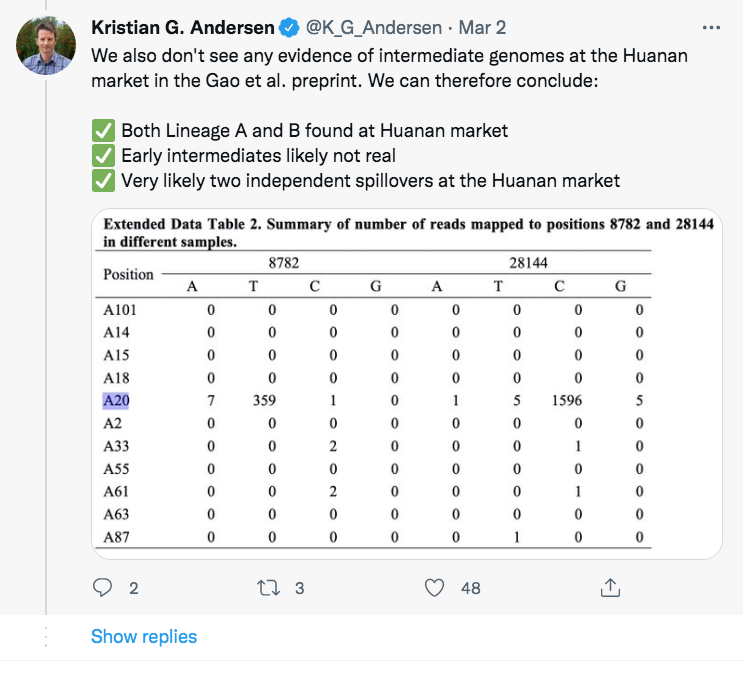Maybe not yet, but we are getting awfully close.
I’m doing this post partly because I think people are underestimating the importance of recent research on the origin of SARS-CoV-2, which points more and more strongly to a zoonotic origin. Matt Yglesias has a very sharp analytical mind, but I’m not sure that even he is quite seeing the picture.
There’s essentially only one important remaining piece of evidence pointing to a lab leak, the fact that Covid first appeared in Wuhan, which contains a virus research lab. That’s consistent with both a lab leak from a natural sample or a lab leak from gain-of-function research. All of the other so-called evidence pointing to a lab leak has been thoroughly discredited. To his credit, Yglesias doesn’t rely on the discredited evidence, just the coincidence of the virus popping up in Wuhan.
I’d like to make two points here. First, the virus emerging in Wuhan is nowhere near as a much of a weird coincidence as one might think. Second, evidence pointing to a zoonotic origin is a bit stronger than Yglesias assumes.
Let’s start with SARS1, which everyone agrees is of natural origin. It first appeared in 2002 in Foshon, which is part of the huge Guangzhou metro area in the even more massive Pearl River delta metroplex. That city is nearly as far from the bat caves of Yunnan as is Wuhan. It also appeared in November, just as did the outbreak in Wuhan. The first known cases were associated with an animal market, just as in Wuhan. Furthermore, Wuhan is in Hubei province, which is full of the sort of mammals that provide a plausible transmission to humans:

Please read his entire thread.
BTW, Andersen’s source is a 2008 paper, for all you conspiracy theorists.
Here’s what you need to know about virus outbreaks:
1. Southern China is different from northern China; they eat lots of unusual animals.
2. The animals are brought to large markets in big cities, where disease outbreaks tend to occur.
3. This has been going on for a long time—remember the Hong Kong flu? (Which didn’t necessarily begin in HK, but was first noticed in the Pearl River delta area.) China has been a leading source for global pandemics throughout history.
The biggest metro areas in south China are the Pearl River Delta metroplex, Wuhan, Chongqing and Chengdu. These are the cities where you’d expect a new global pandemic to begin. And more specifically, you’d expect the pandemic to begin in an animal market in one of those big cities. So please don’t anyone tell me that it’s a one in a thousand chance that Covid would begin in a Wuhan animal market, that’s nonsense.
The new research shows that the Covid-19 outbreak did first show up near a Wuhan animal market, something Yglesias acknowledges. But he also suggests that it might have begun there due to a superspreading event when a lab worker visited the market (or a nearby location) and infected lots of other people. But there are all sorts of problems with this hypothesis.
First the obvious. Wuhan is a crowded city of 11 million people. It has thousands of crowded sites where a superspreading event could have occurred. Why the animal market? Many people wrongly view it as an amazing coincidence that the outbreak occurred in Wuhan of all places, but it really would be an amazing coincidence of a lab worker brought the virus to the animal market of all places for which a superspreading event could have occurred. The “I don’t believe in coincidences” argument points strongly to a zoonotic origin.
One response is that the market is near the center of Wuhan. But it’s not just that the early cases were in the central Wuhan area; a disproportionate number were clearly associated with the market itself. Why?
Second, there doesn’t even seem to have been a superspreading event at the animal market:

And this:

Thus the spillover occurred over days and weeks, and involved two variants, A and B. Models suggest there’s only a 3.6% chance B mutated to A in humans, and what are the odds of two lab leaks?
Michael Worobey also has a good tweet thread. Here’s one point:

3. Also note that environmental samples from the animal market showed SARS-CoV-2. They could have come from humans (the animals were unfortunately destroyed), but the fact that they were more concentrated in areas of the market containing wildlife animals is at least a suggestive piece of evidence.
Does the destruction of the wildlife at the market suggests a Chinese cover-up? Absolutely. China had been heavily criticized for these markets, and China claims that the Wuhan market did not contain wildlife. We now have conclusive evidence that that was a lie. China is covering up the fact that Covid likely began in a animal market in Wuhan. There is no doubt about the cover-up; the only question is whether they are covering up something that actually happened. Indeed the Chinese are now rejecting these new studies pointing to the animal market:
In the new preprint, Gao and colleagues analyzed 1380 samples from 188 animals in the market and the environment, including sewer wells, the ground, feather removing machines, and “containers.” They found SARS-CoV-2 in 73 samples. But because all were from the environment, not the animals themselves, they assert that humans introduced the virus to the market. The authors call the market an “amplifier,” not the source, of SARS-CoV-2.
Hewing closely to government assertions on COVID-19’s origin, the preprint by Gao and colleagues notes studies that have reported evidence of SARS-CoV-2 in other countries before it surfaced in Wuhan, making no mention of critiques that attribute that evidence to contamination. It also floats a widely disputed theory that frozen food imported to China might have been the original source. (Authors of the paper, including Gao, did not respond to requests to discuss the work.)
BTW, for you who like coincidences, chew on this one. Only once in my life did I ever see wildlife (about to be eaten) being kept in cages right on a table of the dining area of a restaurant. It was back in 1994, as I was eating one night at an outdoor restaurant and noticed out of the corner of my eye that a bag was moving slightly, just one table over to my left. On closer inspection, it was a mesh bag full of dozens of frogs, attempting to hop around. It gave me a really queasy feeling. And guess what:
The restaurant was in China.
The restaurant was in Wuhan, China.
The restaurant was in the old colonial section of Wuhan, 2 miles southeast the animal market where Sars-Cov-2 first emerged.
Coincidence? Queue the Twilight Zone music.
For many people Wuhan is just a word. For me, it’s a massive urban area full of dense crowds of people and weird animal consumption patterns. I’m not in the least surprised that Wuhan is the origin of the Covid pandemic.
On one point I agree with Yglesias. Regardless of the origin of Covid-19, virus research has the potential of being extremely dangerous and should be regulated in such a way as to reduce tail risk of an artificially engineered pandemic. That’s what we should be focusing on.
PS. If you are not aware of how the other lab leak evidence has been discredited, read this.
PPS. These new studies seem to be shifting opinion:
The studies were posted as preprints and are not peer reviewed, but scientists, biosecurity experts, journalists, and others are already intensely examining their details. “I have been brought closer to the zoonosis side with these preprints,” says Flo Débarre, an evolutionary biologist at the French national research agency, CNRS, who has followed the origin debate closely and not thrown her lot with either the natural-origin or the lab-leak camp. Evolutionary biologist William Hanage of Harvard University agrees these studies “will be taken as a blow” to the lab-leak hypothesis. “They substantially move the needle on the origins in the direction of the market,” Hanage says.